RICHARD III OF ENGLAND
(2 October 1452 – 22 August 1485) REBURIEL
மூன்றாம் ரிச்சர்ட் - ஒரு மறு அடக்கத்தின் கதை
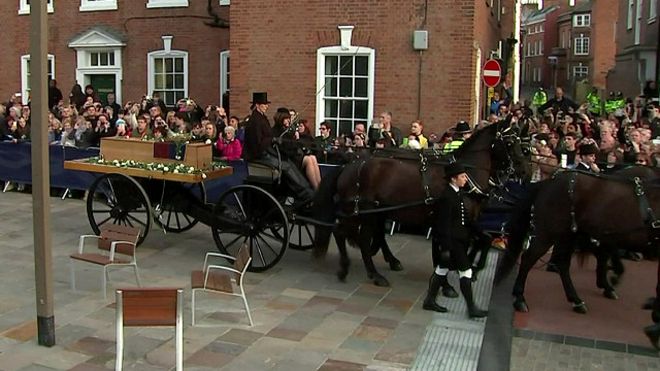
பிரிட்டனில் இன்று ( வியாழன்) ஒரு மன்னனின் உடல் அடக்கம் செய்யப்பட்ட்து.
ஆனால் தற்போதைய ராஜ குடும்பத்தைச் சேர்ந்த எவரும் இறந்துவிடவில்லை.
இன்று அடக்கம் செய்யப்பட்ட எலும்புக்கூடு , 500 ஆண்டுகளுக்கு முன்னர் ஆட்சி செய்த அரசர் ஒருவருக்குச் சொந்தமானது.
பிலாண்டஜெனட் வம்சத்தைச் சேர்ந்த கடைசி மன்னன் மூன்றாம் ரிச்சர்ட்
குழந்தைகளைக் கொன்றவர் என்று அவர் மீது அவரது விரோதிகள் குற்றம் சாட்டினர்.இங்கிலாந்தின் சிம்மாசனத்தை அவர் தனது உறவினர்களிடமிருந்தே பறித்துக்கொண்டார் என்றும் அவர்கள் கூறுகின்றனர்.
பின் அவருக்கு ஏன் இந்த அளவு ராஜ மரியாதையுடன் கூடிய ஒரு இறுதிச்சடங்கு ?
எப்படிக் கண்டுபிடித்தனர் ?
செப்டம்பர் 2012. இங்கிலாந்தின் லெஸ்டர் நகரில் தோண்டிக்கொண்டிருந்த அகழ்வாய்வாளர்கள் ஒரு கார் நிறுத்துமிடத்தின் கீழ் பிரமிக்கத்தக்க ஒரு விஷயத்தைக் கண்டுபிடித்தனர்.
பல நூற்றாண்டுகளுக்கு முன்னர் அவசரகதியில் அங்கு புதைக்கப்பட்ட ஒரு மனிதனின் சடலத்தின் எச்சங்களை அவர்கள் கண்டுபிடித்தனர்.
இந்த சடலம் இங்கிலாந்தின் மிகவும் சர்ச்சைக்குரிய மன்னர்களில் ஒருவரான மூன்றாம் ரிச்சர்டின் சடலமாக இருக்கலாம் என்று அவர்கள் பலமாக சந்தேகித்தனர்
இந்த எலும்புக்கூட்டின் முதுகெலும்பு வளைந்திருந்தது. மன்னர் மூன்றாம் ரிச்சர்ட் கூன் முதுகு கொண்டவர் என்று கூறப்பட்டு வந்தது. அது மட்டுமல்லாமல், இந்த எலும்புக்கூட்டில் போரில் விளைந்த காயங்கள் தெளிவாகக் காணப்பட்டன.
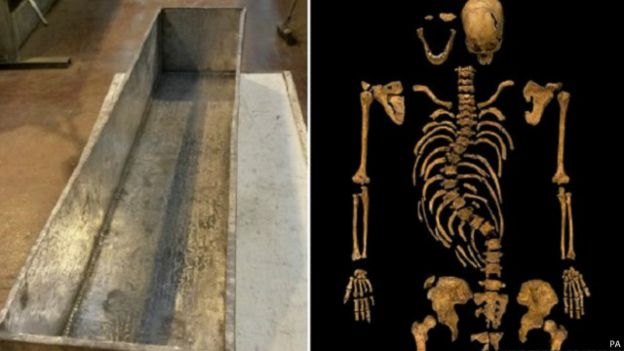 PA
PA
இந்த மன்னரின் பரம்பரையில் வந்து இன்னும் வாழ்ந்துகொண்டிருக்கின்ற ஒருவரின் உடலிலிருந்து பெற்ற மரபணுவை, இந்த எலும்புக்கூட்டிலிருந்து கிடைத்த மரபணுவுடன் இதை ஒப்பிட்டுப் பார்த்த ஆராய்ச்சியாளர்கள் இந்த எலும்புகள் உண்மையில் யார்க்கைச் சேர்ந்த பிலாண்டஜெனட் வம்சத்தின் ரிச்சர்ட் மன்னனுடையதுதான் என்று உறுதிப்படுத்தினர்.
இந்த கண்டுபிடிப்பை அடுத்துத்தான், தொடர்ச்சியான பல சம்பவங்களுக்குப் பின்னர், வியாழக்கிழமை, இந்த 500 ஆண்டுகளுக்கு முன்னர் இறந்த மன்னரின் உடல் எச்சங்கள் லெஸ்டர் தேவாலயத்தில் மீண்டும் அடக்கம் செய்யப்படுகின்றன.
இது தொடர்பாக நடந்த பிரார்த்தனை சேவையில் பல முக்கிய பிரமுகர்கள் கலந்துகொண்டனர். இங்கிலாந்து திருச்சபையின் தலைவரான , கேண்டர்பரி பேராயர் இந்த நிகழ்ச்சிக்குத் தலைமை தாங்கினார்.
தற்போதைய ராஜ குடும்பத்தின் மூன்று உறுப்பினர்களும் இதில் கலந்து கொண்டனர்.
ஆனாலும், மூன்றாம் ரிச்சர்டின் உடல் எச்சங்கள் கண்டுபிடிக்கப்பட்ட சம்பவம், இங்கிலாந்தின் வன்முறை கலந்த கடந்த காலத்தின் மையமாக இருக்கும் பல சர்ச்சைகளை மீண்டும் கிளறி வெளிக்கொண்டு வந்திருக்கிறது.
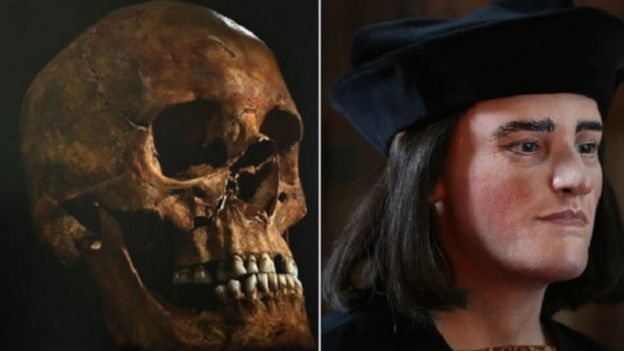 GETTY
GETTYயார் இந்த மூன்றாம் ரிச்சர்ட்
இங்கிலாந்தை 1154ம் ஆண்டிலிருந்து ஆண்ட பரம்பரையான பிலாண்டஜெனட் வம்சத்தைச் சேர்ந்த ரிச்சர்ட் 1452ல் பிறந்தார். இந்த பரம்பரை ஆதியில் பிரான்ஸிலிருந்து வந்த்து.
‘ரோஜாப் போர்கள்’ (Wars of the Roses) என்று அறியப்படும் ரத்தகளறியான உள்நாட்டுப் போர்க் காலகட்ட்த்தில் ரிச்சர்ட் தனது குழந்தைப் பருவத்தைக் கழித்தார். ( இந்தப் போரில் எதிரெதிர் குழுக்கள் தங்களது பரஸ்பர குறியீடாக சிகப்பு மற்றும் வெள்ளை ரோஜாக்களை பயன்படுத்தியதால் இந்த உள்நாட்டுப்போருக்கு இந்தப் பெயர் வந்தது.)
அவரது சகோதரர் மன்னர் நான்காம் எட்வர்ட் இறந்த பின்னர், அவருக்கு பின்னர் மன்னராக வேண்டிய ,ரிச்சர்டின் இளம் மருமகன், 12 வயது மன்னர் ஐந்தாம் எட்வர்டுக்கு , பாதுகாப்பாளராக ரிச்சர்ட் நியமிக்கப்பட்டார்.
அடுத்து என்ன நடந்தது என்பதுதான் மிகவும் சர்ச்சைக்குரிய விவகாரமாக இருந்து வந்திருக்கிறது.
அடுத்த சில மாதங்களில், இந்த இளம் மன்னரும் அவரது ஒன்பது வயது சகோதரரும் சிறையாகவும் கோட்டையாகவும் இருந்த 'டவர் ஒஃப் லண்டன்' கோட்டைக்குள்ளிருந்து காணாமல் போய்விட்டனர்.
அந்த சமயத்தில் ரிச்சர்டின் இறந்த சகோதரரின் திருமணம் சட்டவிரோதமானது என்று அறிவிக்கப்பட்டு, அதன் காரணமாக ஐந்தாம் எட்வர்ட் அரசராக முடியாது என்றும் பொருள் கூறப்பட்டது.
வசதியாக, ரிச்சர்ட்டே அரச பட்டத்துக்குரியவர்கள் வரிசையில் அடுத்தபடியாக இருந்தார்
அவர் மன்னராக முடிசூட்டப்பட்டார். அவரது இளம் மருமகன்கள் மீண்டும் காணப்படவேயில்லை.
அவர்களை ரிச்சர்ட் கொலை செய்து, லண்டன் கோட்டையிலேயே எங்கோ புதைத்துவிட்டார் என்று அவரை விமர்சிப்பவர்கள் கூறுகின்றனர்.
போஸ்வொர்த் போர்
மத்தியகாலத்தில் ஆண்ட எந்த ஒரு மன்னனும் இது போன்ற வெற்றிகளுடன் சும்மா இருந்து விட முடியாது. அவரது நாட்டுக்குள்ளும், நாட்டுக்கு வெளியிலிருந்தும் எதிரிகள் அவரை சூழ்ந்த வண்ணம் இருந்தனர். தங்களுக்கும் ஒரு வாய்ப்பு கிடைக்காதா என்று காத்துக்கிடந்தனர்.
பலவந்தமாக ஆட்சிக்கட்டிலேறியதால், ரிச்சர்டுக்கு, ட்யூடர் வம்சத்தைச் சேர்ந்த ஹென்றி உட்பட பல விரோதிகள் இருந்தனர். ஹென்றி சிம்மாசனத்துக்குச் சொந்தம் கொண்டாடிய பலரில் ஒருவர். அவர் ரிச்சர்டை வீழ்த்த அவரது எதிரிகளுடன் சேர்ந்து கொண்டார்.
இந்த நடவடிக்கைகளின் உச்சமாகத்தான் லெஸ்டர்ஷையரில் நடந்த போஸ்வொர்த் போர் வந்தது.
போரில் கொல்லப்பட்ட கடைசி இங்கிலாந்து மன்ன்ன் மூன்றாம் ரிச்சர்ட்தான். அவருக்குப் பின்னர் ட்யூடர் வம்சத்தின் முதல் மன்ன்னாக ஆட்சிக்கு வந்தார் ஹென்றி, ஏழாம் ஹென்றி என்ற பெயருடன்.
ரிச்சர்டின் உடல் ஒரு ஆற்றில் வீசப்பட்டதாக வதந்திகள் நிலவின.
ஆனால் அவரது உடல் அருகிலிருந்த ஒரு மடாலயத்துக்கு சொந்தமான நிலத்தில் அவசரகதியில் , ராஜ மரியாதைகள் ஏதுமின்றி அடக்கம் செய்யப்பட்ட்தாக இப்போது தெரிகிறது. அந்த இடம் தான் தற்போது அவரது உடலின் எச்சங்கள் கண்டுபிடிக்கப்பட்ட கார்கள் நிறுத்துமிடம்.
வென்றவர்கள்தான் வரலாற்றை எழுதுகிறார்கள் என்பது தெரிந்த ஒரு விஷயம்தான்.
ட்யூடர்கள் ஆட்சிக்கு வந்தவுடன் ரிச்சர்டின் பெயரைக் களங்கப்படுத்துவதில் ஈடுபட்டனர்.
அவர் செய்த உண்மையான குற்றங்களைச் சொல்வதுடன் மட்டும் அவர்கள் திருப்தியடையவில்லை.
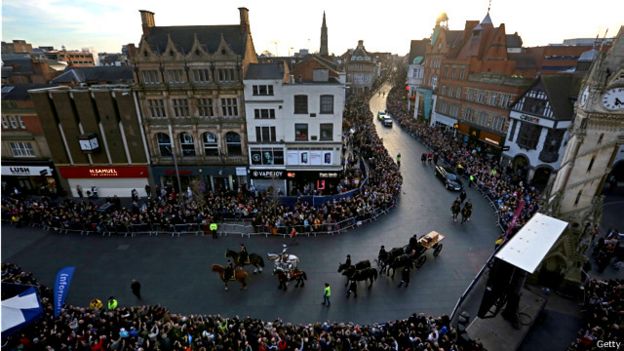 GETTY
GETTYரிச்சர்டின் மற்றொரு முகம்
உலகப் பிரசித்தி பெற்ற ஆங்கில நாடகாசிரியர், வில்லியம் ஷேக்ஷ்பியர், இறந்த மன்ன்ன் ரிச்சர்டை, கூன் விழுந்த ராட்சதன் என்று வர்ணித்தார்.
ஆனால் ரிச்சர்டுக்கு மற்றொரு சீர்திருத்த முகமும் இருந்த்து.
அவர் எடுத்த நடவடிக்கைகள் பல ஏழை மக்களுக்கு நீதியை அணுகும் வாய்ப்பைப் பெற்றுத்தந்தன.
ஜாமின் எனப்படும் முறையை அவர்தான் முதன் முதலில் அறிமுகப்படுத்தினார்.
சட்டங்களை பிரெஞ்சு மொழியிலிருந்து ஆங்கில மொழிக்கு மொழி பெயர்த்தார்.
போஸ்வொர்த் போரில் ரிச்சர்ட் வென்றிருந்தால், ஆங்கிலேய வரலாறு வேறு மாதிரி இருந்திருக்கும்.
ஆறு பெண்களை மணந்து கொண்ட எட்டாம் ஹென்றியும், அவரது ட்யூடர் வம்சமும் ஆட்சி செய்யமுடியாமலே போயிருக்கும்.
எட்டாம் ஹென்றி ரோமன் கத்தோலிக்க திருச்சபையுடன் இங்கிலாந்திருக்கிருந்த தொடர்புகளை துண்டித்து, இங்கிலாந்து திருச்சபையை நிறுவிய சம்பவம் நடந்திருக்காது.
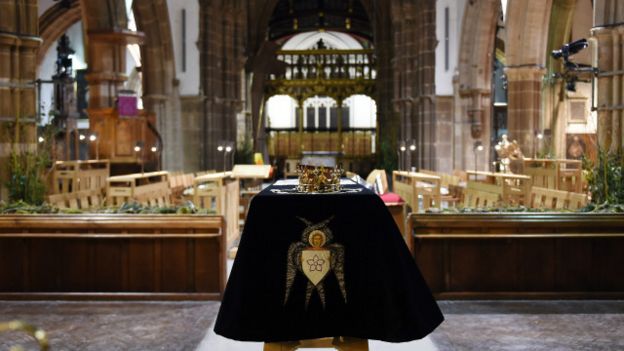 EPA
EPA
ரிச்சர்டே ஒரு கத்தோலிக்கர் என்ற நிலையில், அவரை எப்படி ஒரு ப்ரோட்டஸ்டண்ட் தேவாலயத்தில் அடக்கம் செய்ய முடியும் என்று பலர் கேள்விகளை எழுப்பவும் இது வழி வகுத்த்து.
தற்போதைய ராஜ குடும்பம், சிம்மாசனத்துக்கு தங்கள் தொடர்பைக் குறிப்பிடும்போது, ட்யூடர்கள் வம்சத்துடனும் அதற்கும் முந்தைய வம்சங்களுடனும் தொடர்பு இருப்பதாக்க் கூறிக்கொள்ளும் நிலையில், அவர்களது கூற்றுகள் பற்றியும் கேள்விகள் எழுகின்றன.
இந்த நிகழ்வை வைத்துப் பார்த்தால், தற்போதைய பிரிட்டிஷ் அரசி, இரண்டாம் எலிசபத்தே கூட , முற்றிலும் வேறான, மேலும் சாதாரணமான ஒரு வாழ்க்கையை வாழ வேண்டியிருந்திருக்கும்.
ரோஜாப் போர்கள் – பாகம் இரண்டு
மூன்றாம் ரிச்சர்ட் மன்னனின் உடல் மறு அடக்கம் செய்யப்பட்ட நிகழ்வு, அதன் தொடர்பான வரலாற்று ரீதியான போர், கொலை ,ராஜ குடும்பக் கதைகளுடன் சேர்ந்து, பிரிட்டனில் பலரது கவனத்தை ஈர்த்த ஒரு விஷயமாகிவிட்ட்து.
ஆனால் குழந்தைகளைக் கொன்றதாக சந்தேகிக்கப்படும் ஒருவரை இப்படி கௌரவிப்பது என்பது கண்ணியமான விஷயமல்ல என்று சில விமர்சகர்கள் கூறுகின்றனர்.
மறு அடக்கம் செய்யப்படும் நிகழ்வில் பொதுமக்கள் அஞ்சலியில் காணப்பட்ட சில விஷயங்கள் குறித்து சற்று அதிர்ச்சி கூட நிலவுகிறது.
ரிச்சர்டின் உடல் எச்சங்கள் லெஸ்டர் நகரில் , ஆயுதந்தாங்கிய படையினர் புடை சூழ, வண்டியில் எடுத்துச் செல்லப்பட்ட்து. அப்போது சில பார்வையாளர்கள் , பல நூற்றாண்டுகளுக்கு முன்னர் இறந்த இந்த மனிதனுக்காக, கண்ணீர் வடித்தனர்.
லெஸ்டருக்கு ரிச்சர்டால் யோகம்
அரசராவதற்கு முன்னர் யார்க் ரிச்சர்ட் என்று அறியப்பட்ட மூன்றாம் ரிச்சர்ட்டின் தற்போதைய வாரிசுகள் இப்போது ‘ப்ளாண்டஜெனட் கூட்டணி’ என்ற அமைப்பை வைத்திருக்கிறார்கள். அவர்கள் ரிச்சர்ட் யார்க் நகரில்தான் அடக்கம் செய்யப்ப்டவேண்டும் லெஸ்டரில் அடக்கம் செய்யப்படக்கூடாது என்று வாதிட்டனர்.
இந்த வாதப்பிரதிவாதங்கள் சூடுபிடித்து, நீதிமன்றம் வரை சென்றது, ஆனால் வழக்கில் லெஸ்டர் வென்று , இப்போது ரிச்சர்ட் மறு அடக்கத்தால் கிடைக்கும் லாபங்களை அது அனுபவிக்கத் தொடங்கியிருக்கிறது.
ரிச்சர்ட் விவகாரத்துக்கு கிடைத்த விளம்பரத்தால், லெஸ்டர் பகுதிக்கு சுற்றுலா மூலம் கிடைக்கும் வருவாய், சுமார் 700 மிலியன் டாலர்களுக்கும் மேலாக உயர்ந்திருப்பதாக ஒரு ஆய்வு காட்டுகிறது.
லெஸ்டர் மீது தான் கண் வைத்த்து குறித்து ரிச்சர்ட் வேண்டுமானால் வருந்தியிருக்கலாம். ஆனால் லெஸ்டர் நகரம் அவர் அங்கு வந்த்து குறித்து மிகவும் மகிழ்ச்சி அடையும்
யானை இருந்தாலும், இறந்தாலும், ஆயிரம் பொன் அல்லவா ?
Site of Greyfriars Church, Leicester, shown superimposed over a modern map of the area. The skeleton of Richard III was recovered in September 2012 from the centre of the choir, shown by a small blue dot.
On 5 September 2012, the excavators announced that they had identified Greyfriars church[257] and two days later that they had identified the location of Robert Herrick's garden, where the memorial to Richard III stood in the early 17th century.[258] A human skeleton was found beneath the Church's choir.[259]
Improbably, the excavators found the remains in the first location in which they dug at the car park. Coincidentally, they lay almost directly under a roughly painted 'R' on the tarmac. This had existed since the early 2000s to signify a reserved parking space.[260][261][262]
On 12 September, it was announced that the skeleton discovered during the search might be that of Richard III. Several reasons were given: the body was of an adult male; it was buried beneath the choir of the church; and there was severe scoliosis of the spine, possibly making one shoulder[263] higher than the other (to what extent depended on the severity of the condition). Additionally, there was an object that appeared to be an arrowhead embedded in the spine; and there were perimortem injuries to the skull. These included a relatively shallow orifice, which is most likely to have been caused by a rondel dagger, and a scooping depression to the skull, inflicted by a bladed weapon, most probably a sword. Additionally, the bottom of the skull presented a gaping hole, where a halberd had cut away and entered it. Forensic pathologist, Dr Stuart Hamilton stated that this injury would have left the King's brain visible, and most certainly would have been the cause of death. Dr Jo Appleby, the osteo-archaeologist who excavated the skeleton, concurred and described the latter as "a mortal battlefield wound in the back of the skull". The base of the skull also presented another fatal wound in which a bladed weapon had been thrust into it, leaving behind a jagged hole. Closer examination of the interior of the skull revealed a mark opposite this wound, showing that the blade penetrated to a depth of 10.5 cm.[264] In total, the skeleton presented 10 wounds: 4 minor injuries on the top of the skull, 1 dagger blow on the cheekbone, 1 cut on the lower jaw, 2 fatal injuries on the base of the skull, 1 cut on a rib bone, and 1 final wound on the King's pelvis, most probably inflicted after death. It is generally accepted that postmortem, Richard's naked body was tied to the back of a horse, with his arms slung over one side and his legs and buttocks over the other. This presented a very opportunistic target for onlookers, and the angle of the blow on the pelvis suggests that one of them stabbed Richard's right buttock with substantial force, as the cut extends from the back all the way to the front of the pelvic bone and was most probably an act of humiliation. It is also possible that Richard suffered other injuries which left no trace on the skeleton.[265][266][267]
In 2004, the British historian John Ashdown-Hill had used genealogical research to trace matrilineal descendants of Anne of York, Richard's elder sister.[268] A British-born woman who emigrated to Canada after the Second World War, Joy Ibsen (née Brown), was found to be a 16th-generation great-niece of the king in the same direct maternal line.[269][270] Joy Ibsen's mitochondrial DNA was tested and belongs to mitochondrial DNA haplogroup J, which by deduction, should also be the mitochondrial DNA haplogroup of Richard III.[176] Joy Ibsen died in 2008. Her son Michael Ibsen gave a mouth-swab sample to the research team on 24 August 2012. His mitochondrial DNA passed down the direct maternal line was compared to samples from the human remains found at the excavation site and used to identify King Richard.[271][272][273][274]
On 4 February 2013, the University of Leicester confirmed that the skeleton was beyond reasonable doubt that of King Richard III. This conclusion was based on mitochondrial DNA evidence,[275] soil analysis, and dental tests (there were some molars missing as a result of caries), as well as physical characteristics of the skeleton which are highly consistent with contemporary accounts of Richard's appearance.[276] The team announced that the "arrowhead" discovered with the body was a Roman-era nail, probably disturbed when the body was first interred. However, there were numerous perimortem wounds on the body, and part of the skull had been sliced off with a bladed weapon;[277] this would have caused rapid death. The team concluded that it is unlikely that the king was wearing a helmet in his last moments. Soil taken from the Plantagenet King's remains was found to contain microscopic roundworm eggs. Several eggs were found in samples taken from the pelvis, where the king's intestines were, but not from the skull and only very small numbers were identified in soil surrounding the grave. The findings suggest that the higher concentration of eggs in the pelvic area probably arose from a roundworm infection the King suffered in his life, rather than from human waste dumped in the area at a later date, researchers said. The Mayor of Leicester announced that the king's skeleton would be re-interred at Leicester Cathedral in early 2014, but a judicial review of that decision delayed the reinterment for a year.[278] A museum to Richard III was opened in July 2014 in the Victorian school buildings next to the Greyfriars grave site.[8][275][279][280]
The proposal to have King Richard buried in Leicester attracted some controversy. Those who challenged the decision included fifteen 'collateral [non-direct] descendants' of Richard,[281] represented by the Plantagenet Alliance, who believe that the body should be reburied in York, as they claim the king wished.[281] In August 2013, they filed a court case in order to contest Leicester's claim to re-inter the body within its cathedral, and propose the body be buried in York instead. However, Michael Ibsen, who gave the DNA sample that identified the king, gave his support to Leicester's claim to re-inter the body in their cathedral.[281] On 20 August, a judge ruled that the opponents had the legal standing to contest his burial in Leicester Cathedral, despite a clause in the contract which had authorized the excavations requiring his burial there. He urged the parties, though, to settle out of court in order to "avoid embarking on the Wars of the Roses, Part Two".[282] The Plantagenet Alliance, and the supporting fifteen 'collateral [non-direct] descendants', also faced the challenge that 'Basic maths shows Richard, who had no surviving children but five siblings, could have millions of "collateral" descendants' and they don't represent 'the only people who can speak on behalf of him', as one member claimed.[281] A ruling in May 2014 decreed that there are "no public law grounds for the Court interfering with the decisions in question".[283] The remains were taken to Leicester Cathedral on 22 March 2015 and reinterred on 26 March.[284]
On 5 February 2013 Professor Caroline Wilkinson of the University of Dundee conducted a forensic facial reconstruction of Richard III, commissioned by the Richard III Society, based on 3D mappings of his skull. The face is described as "warm, young, earnest and rather serious".[285] On 11 February 2014 the University of Leicester announced the project to sequence the entire genome of Richard III and one of his living relatives, Michael Ibsen, whose mitochondrial DNA confirmed the identification of the excavated remains. Richard III thus became the first ancient person of known historical identity to have their genome sequenced.[286]
In November 2014, the results of the testing were announced, confirming that the maternal side was as previously thought.[287] The paternal side, however, demonstrated some variance from what had been expected, with the DNA showing no links to the purported descendants of Richard's great-great-grandfather Edward III of England through Henry Somerset, 5th Duke of Beaufort.[288] This could be the result of misattributed paternity that does not reflect the accepted genealogies between Richard and Edward III or between Edward III and the 5th Duke of Beaufort.[288][289]
Reburial and tomb[edit]
Tomb of Richard III
In 1485, following his death in battle against Henry Tudor at Bosworth Field, Richard III's body was buried in Greyfriars Church in Leicester.[290]
Following the discoveries of Richard's remains in 2012, it was decided that they should be reburied at Leicester Cathedral,[291][292] despite feelings in some quarters that he should have been reburied in York Minster.[293] His remains were carried in procession to the cathedral on 22 March 2015, and reburied on 26 March 2015[294] at a religious re-burial service at which both the Right Reverend Tim Stevens, the Bishop of Leicester, and the Most Reverend Justin Welby, the Archbishop of Canterbury, officiated. The British Royal Family was represented by the Duke and Duchess of Gloucester and the Countess of Wessex. The actor Benedict Cumberbatch, who is a distant relation of the king and later portrayed him in The Hollow Crown television series, read a poem by Poet Laureate Carol Ann Duffy.[10][295][296]
His cathedral tomb was designed by the architects van Heyningen and Haward. The tombstone is deeply incised with a cross, and consists of a rectangular block of white Swaledale fossil stone, quarried in North Yorkshire. It sits on a low plinth made of dark Kilkenny marble and incised with Richard’s name, dates and motto. The plinth also carries his coat of arms in pietra dura.[297] The remains of Richard III are in a lead-lined coffin,[298] inside an outer English oak coffin crafted by Michael Ibsen, a direct descendant of Richard's sister Anne of York, and laid in a brick-lined vault below the floor, and below the plinth and tombstone.[297] The original 2010 raised tomb design had been proposed by Langley`s "Looking For Richard Project" and fully funded by members of the Richard III Society. The proposal was publicly launched by the Society on 13 February 2013 but rejected by Leicester Cathedral in favour of a memorial slab.[299][300][301] However, following a public outcry, the Cathedral changed its position and on 18 July 2013 announced its agreement to give King Richard III a raised tomb monument.[302][303





No comments:
Post a Comment